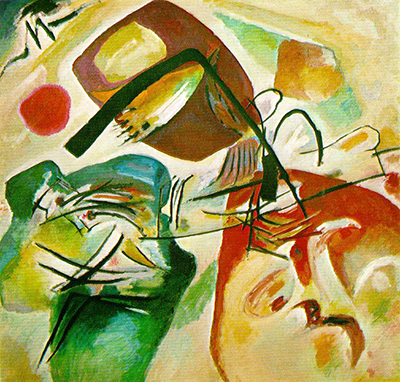Picture with a Black Arch dates from 1912 and features an abstract interpretation of Russian themes. The three main areas of colour formulate the Troika.
The artist makes use of a limited palette here, allowing each item to retain a greater clarity. Much of his work around this time was similarly coloured like this, but just previously he had been working on a number of landscape paintings that were not as abstract as this. It takes considerable research in order to understand quite what is going on here, such is the level of abstraction with which Kandinsky is now working. The best clues can be gleaned by examining some of the other artworks that he produced around this time and also to look into the themes of Russia which were still very much at the forefront of his work at this stage. Russia itself has provided many countries with immigrant artists who have gone on to become household names, and Kandinsky, born in Moscow, is just one example of that.
Some have suggested a musical element to this work, which is something that Kandinsky was interested in. He wanted to visualise sound and would experiment with different ways of doing so, just as Klee would do at around the same time. It is believed that he took ideas from Arnold Schönberg, a European composer, on how to create an impact and also on fusing sound and imagery together in a meaningful way. He was heavily involved in theory and would also later produce his own publications to extend thinking further.
This picture can be found in the collection of the Centre Georges Pompidou in Paris, France. They have the piece listed under both French and German titles, as Mit dem schwarzen Bogen (Avec l'Arc noir). They own a number of other items from Kandinsky's career plus other prominent names such as Henri Matisse, Marc Chagall and Fernand Leger. It competes admirably against some other extraordinary art venues to be found in this culturally significant city, such as the Louvre and the Musee D'Orsay. It benefits from covering an alternative period in European art history to those establishments, allowing it to retain an alternative art following.




